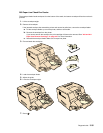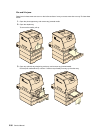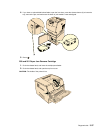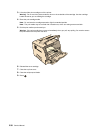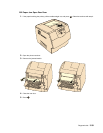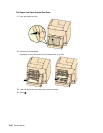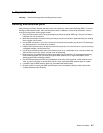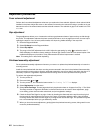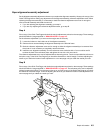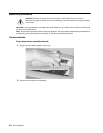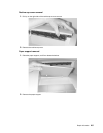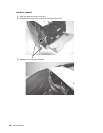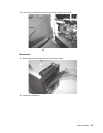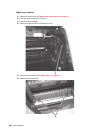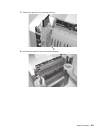
4-2 Service Manual
Adjustment procedures
Fuser solenoid adjustment
Perform the fuser solenoid adjustment whenever you replace the fuser solenoid. Adjust the fuser solenoid while
installed in the printer. Adjust the screw on the eccentric mounted on the solenoid housing to provide an air gap
between the rear of the solenoid stator and the solenoid armature. The solenoid air gap for all models is 4.5 mm
± 0.1 mm.
Gap adjustment
The gap adjustment allows you to increase the minimum gap between sheets of paper as they are fed through
the printer. This adjustment reduces the printer overall performance, such as pages per minute, but can help in
reducing the amount of curl of some printed media, thus improving media stacking in the output bin.
1. Enter the Diagnostic Mode.
2. Select Ep Setup from the Diagnostic Menu.
3. Select Gap Adjust.
4. The range of the GAP adjustment is 0 to 255. Adjust the gap setting by using to select the value. If
GAP=0 displays, it indicates a factory setting to minimum gap. Select a value and run several copies of the
media that displays a curl problem. It may take several tries before improvement is noticed.
Note: This setting has no effect when duplexing.
Printhead assembly adjustment
Do the printhead assembly adjustment whenever you remove or replace the printhead assembly or loosen the
mounting screws.
Install the new printhead with the three mounting screws centered in the slots in the printhead frame assembly.
Leave the screws loose enough to allow the printhead assembly to move from side to side within the slots. It is
necessary to perform a registration adjustment before locking down the three printhead mounting screws.
To perform the registration adjustment:
1. Turn the printer off.
2. Press and hold and .
3. Turn the printer on, and release the buttons when Performing Self Test displays.
4. Select Registration from the menu.
5. Select Quick Test Page. The test page should only be printed on letter or A4 paper from Tray 1. The Quick
Test Page consists of alignment diamonds, horizontal lines that can be used for skew adjustment, page
count setting, printer serial number code levels, and print registration settings.
6. Check the Quick Test Page for any sign of skew by checking the diamonds at the top left and top right of
the test page for equal distance from the top of the page. If necessary, adjust the left or right printhead
mounting screws and check the skew again by running another Quick Test Page. This procedure may take
two or three attempts before you get satisfactory results.
7. When you have the correct adjustment, gently tighten the printhead mounting screws, being careful not to
move the printhead assembly.



